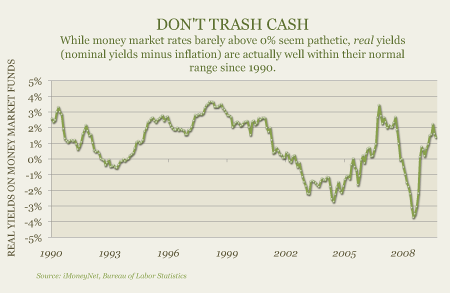Why You Shouldn't Bash Cash
Interest rates on savings and money market accounts have dropped so low that complaining about them has become a national pastime. Fortune columnist Allan Sloan recently ranted that the Federal Reserve, in its effort to keep interest rates low to stabilize home prices, among other reasonable goals, has pulled the rug out from under the nation's diligent savers. "A nice reward from their government for a lifetime of saving," moped Sloan. "Thanks for nothing, guys."
The remembrance of interest past has taken on a nostalgic tone, recalling bygone days when ordinary folks who wouldn’t know a stock from a stick socked away their money in a passbook account and retired comfortably on the compounded earnings. But there are a couple of holes in that wistful thinking.
The Real Role of Cash
First, cash accounts such as savings and money market funds aren’t supposed to make you rich; their modest goal is to stay liquid and keep pace with inflation so time doesn’t decimate your spending power. “Historically, money market accounts do yield about what inflation takes away,” says Steven Pomeranz, a financial adviser in Boca Raton, Fla.
Second, working from the assumption that plain-vanilla cash accounts track inflation, it follows that interest rates on these investments will be low when inflation is low. Right now, inflation is not only nonexistent, it’s actually negative, at least according to the government’s measure. The consumer price index (CPI) for urban wage earners and clerical workers reported that prices dropped 2.1 percent in the third quarter of 2009, compared with the same period last year. As the chart below shows, real money fund yields — that is, yields minus inflation — are near the middle of their range since 1990.
What’s important is not the stated, or nominal, yield on money market funds, but the real yield, which is the difference between the nominal yield and inflation. And while average money market yields in September were just barely above zero at 0.06 percent (you can do better), September’s inflation rate was negative 1.3 percent, which means that the real yield was actually a respectable 1.36 percent. So cash has been doing what it usually does, which is outpace inflation by a small margin. But many investors are missing this point — as are lots of pros. “All too often, advisers forget that having money when you need it is more important than eking out a little better return than the other guy,” says financial planner Sheryl Garrett, founder of the nationwide Garrett Planning Network.
The problem is that so many Americans have retreated to cash as a defensive move in the past year — and watching huge chunks of their nest eggs tread water. “Trillions of dollars in excess cash are just sitting in money markets now,” Pomeranz says. The interest on those investors’ cash seems pathetic. But figuring out how and when to put all that money to work to achieve longer-term growth goals is different from understanding the role that cash is supposed to play in your portfolio, and realizing that it’s actually achieving it now.
What Cash Doesn’t Do
With the foregoing in mind, let’s say you own your home outright (or plan to by retirement), and enjoy a modest lifestyle that does not include biennial kitchen renovations. You’re in reasonably good health and you figure your savings, combined with Social Security, will be enough to live on until age 90 if it can keep up with inflation. Should you keep it all in the bank?
Not exactly, for several reasons: While cash accounts usually pace the CPI, “they may lag behind inflation for extended periods,” says Pomeranz. “We’ve seen periods of time when inflation is higher and money market rates are lower,” he says. Indeed, the returns of 30-day Treasury bills (a proxy for cash) lagged inflation during 20 of the 64 rolling 20-year periods between 1926 and 2008, according to Ibbotson Associates’ 2009 Classic Yearbook.
Also, taxes will eat away at your inflation protection. According to Morningstar, cash holdings earned an average of 3.7 percent annually from 1926 to 2008 — outpacing the average inflation rate of 3 percent. After taxes, however, cash grew at only 2.3 percent, although taxes have historically been much higher than they are now. Hoarding cash in a tax-free or tax-deferred retirement account will help mitigate that problem by allowing your savings to compound pretax, but then, when you do retire, you’ll give up a good chunk of those gains.
Finally, all inflation is not created equal. Some things go up a lot, even when most prices remain stable or even decline. One is college tuition, and another is health care, a major concern for retirees. Even stocks may not keep pace with health care inflation (currently in the double digits, according to Buck Consultants) — and cash has no chance.
Use Cash Wisely
What’s an investor supposed to make of all this? “Sometimes trying to figure out how much to put in a money market is a bit like timing the stock market,” Garrett says. “You just can’t know for sure.”
As is the case with most investing challenges, the best response is usually to diversify. Garrett’s approach would be to put 100 percent of first-year living expenses not covered by Social Security into a money market account, and keep two additional years of expenses in one- and two-year CDs. She would put the rest of the nest egg in government bonds (including inflation-protected TIPS), and some dividend-generating stock funds. “Any interest, dividends, and capital gains should flow into the money market fund, not get reinvested,” she says, to bolster the safety cushion and avoid increasing risk exposure.
Adviser Rick Miller of Sensible Financial in Cambridge, Mass., offers some other tips to protect your nest egg. “When talking about preserving spending power, you have to ask, ‘What are you preserving it for?’ Divide your spending into three categories: spending I must do, spending I might have to do, and spending I would like to do.”
Given this scenario, risk-free investments are for must-do spending, such as basic living expenses. In the early years of retirement, Miller recommends laddering TIPS, and buying single-premium immediate annuities (SPIAs) not variable annuities — to cover food and household expenses. For other spending you might have to do, Miller advises ensuring against it whenever possible — for example, by buying long-term care insurance or supplemental Medicare insurance. But he also recommends keeping some cash around for this category “because you can’t predict everything.” That leaves the spending you would like to do for, say, a trip to Costa Rica. “Here is where you can decide whether you want to take some risk,” says Miller.
Planners say that aging Americans, who have been stung by recent market losses, are likely to opt for less risk going forward. The financial industry is certain to respond with new investment products. Pimco now offers TIPS ladder funds, which own bonds that mature at different times, notes Paula Hogan, a Milwaukee planner. She expects the next innovation will be TIPS ladder funds that guarantee your income after a certain age, but don’t give you anything until you reach it. “People are worried about longevity and inflation risks,” Hogan says, “and it’s beginning to dawn on them that stocks have risks, too, even if you hold onto them for a long time.”
More on MoneyWatch:

